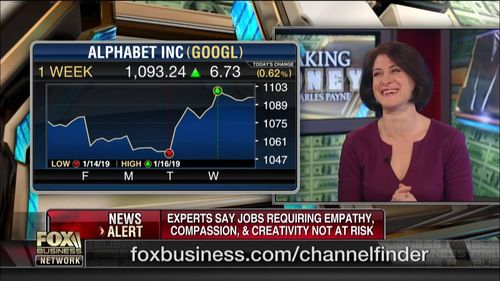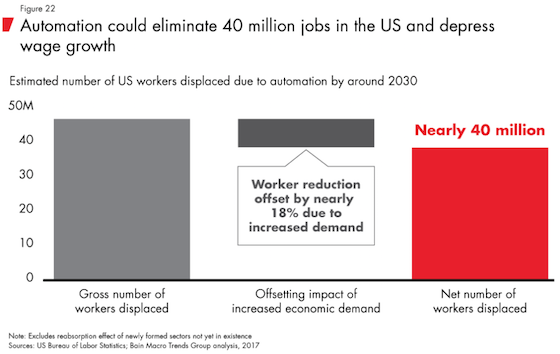


01/19/2019
It’s a rare thing for the massive job loss associated with future automation to be discussed on television, but Wednesday’s coverage on Fox Business followed the Sixty Minutes report last Sunday — a two-fer in one week. But unlike CBS’ Scott Pelley, who seemed afraid to confront the idea that artificial intelligence would displace 40 percent of world jobs within 15 years, Charles Payne waded right in to the thorny topic of technology-caused unemployment in the millions.
Payne’s guest was Karen Harris, Bain & Company’s Macro Trends Group managing director, who is knowledgeable on the topic of the automated future. She was one of three authors in a major paper, Labor 2030: The Collision of Demographics, Automation and Inequality from that company, which reports that “automation may eliminate 20% to 25% of current jobs.”
Below, a chart from Bain & Company’s report Labor 2030 showing that 40 million US jobs are at risk from automation:

So this and other recent input require an update to LTG’s list of technology-unemployment predictions: Oxford researchers forecast in 2013 that nearly half of American jobs were vulnerable to machine or software replacement within 20 years. Rice University computer scientist Moshe Vardi believes that in 30 years humans will become largely obsolete, and world joblessness will reach 50 percent. The Gartner tech advising company believes that one-third of jobs will be done by machines by 2025. The consultancy firm PwC published a report last year that forecast robots could take 38 percent of US jobs by 2030. In November 2017, the McKinsey Global Institute reported that automation “could displace up to 800 million workers — 30 percent of the global workforce — by 2030.” Forrester Research estimates that robots and artificial intelligence could eliminate nearly 25 million jobs in the United States over the next decade, but it should create nearly 15 million positions, resulting in a loss of 10 million US jobs. Kai-Fu Lee, the venture capitalist and author of AI Superpowers: China, Silicon Valley, and the New World Order, forecast on CBS’ Sixty Minutes about automation and artificial intelligence: “in 15 years, that’s going to displace about 40 percent of the jobs in the world.” A February 2018 paper from Bain & Company, Labor 2030 predicted, “By the end of the 2020s, automation may eliminate 20% to 25% of current jobs.”
So America won’t be needing any more low-skilled immigrants, like the thousands streaming here from Honduras etc. Think of all the billions of dollars we could save on various benefits for the uninvited moochers. But Washington remains asleep to the social and economic earthquake facing the nation from the jobless automated future.
Here’s the conversation from Fox Business:
CHARLES PAYNE: The long anticipated age of robots and artificial intelligence is upon us, and as we cheer innovation many wonder what the eventual human toll would be? I was hoping it would blow up the so-called supply chain, the excuse for offshoring American jobs, but then this morning I read about a US camera-equipped robot patrolling grocery store aisles, looking for spills. Now what happens is the robot will detect one and alert a human worker in the control center — in the Philippines. Joining me is managing director of Bain and Company’s Macro Trends Group, Karen Harris. Thanks for joining us.
KAREN HARRIS: Thanks for having me.
PAYNE: We’re all excited about all the automation right there; we’re in the midst of it, right? We are making that transition right now, and there’s a lot of questions about how it impacts jobs, and don’t worry about it, but this time it feels different, doesn’t it?
HARRIS: I think you’re absolutely right. We’re early in the phase of robotics and automation, especially in the service sector. When Bain looked at this project, what we see with machine learning, the kind of sensors you have and human hand dexterity that’s available today — between now and 2030, we could lose 30 to 40 million jobs, which is about 20 to 25 percent of the workforce. So, the most disruptive thing that’s happened to the labor pool in 100 years.
PAYNE: In the past of course, the fears were overcome by productivity, the different jobs that were opened up. I mean, there won’t be a parallel 20 or 30 million jobs that replace those that are lost?
HARRIS: Eventually — I believe in the innovation of the American economy — but eventually we’ll be better off.
PAYNE: But if a robot builds a robot, if a computer gets smarter and smarter — where do we fit in that equation?
HARRIS: Good question. We know there are jobs that humans are better at doing: for example, if you think about elder care. There is a physical labor of helping a older person, but also the cognitive stimulus, playing games, listening to stories …
PAYNE: Reading a teleprompter.
HARRIS: Reading a teleprompter, that forestalls dementia. We’ll see innovation, I think to your point, the transition, this is twice as broad and twice as fast as the transition from agriculture to industry — so it’s going to be a turbulent period while we go through this.
PAYNE: It’s interesting, we’re in the midst of a big dispute with China, and a lot of big businesses are arguing, hey, you’re disrupting supply chain. To me it’s a euphemism for cheap labor. And if robots are doing so many jobs, wouldn’t the supply chain change in and of itself, and shouldn’t we be bigger beneficiaries of that?
HARRIS: The sequencing is something really important here. So when Bain looked at this work, we looked at demographics, automation and the impact on inequality. And what we saw was, right now we’re in a period where for the first time in decades, the labor pool is getting smaller globally. So to your point, as the labor pool is expanding, labor got cheaper overseas, we built the long supply chains.
Now that the labor pool is shrinking in China and Germany, growing more slowly in the US, costs rise, robotics get cheaper, and we see this uptick of automation replacing workers. And so that should and will bring more and more production onshore in developed countries like America and create some real strengths for emerging markets that count on shipping to us.
PAYNE: That’s tough for the emerging markets, great news for America, but in the transition period — in the minute we have left — in your report, you talk about the 10- or 15-year boom, but you also talk about highly skilled or high income labor. When General Motors announced that they were closing a plant, they couldn’t say, hey, we know the people are working at this plant have been working here 30 or 40 years, they couldn’t say but they don’t have the skillset to do what we need them to do, and yet that is really probably what is going on here. How do we get Americans those skillsets?
HARRIS: That is the third step, the demographics, inequality and automation, that the early phases of this go to highly skilled workers …
PAYNE: Who is responsible — government or business or a combination of both?
HARRIS: It has to be combination. Our clients are really worried about helping people who work for them find new jobs and new opportunities, but each individual company can’t help everyone, so we all need to participate in that.